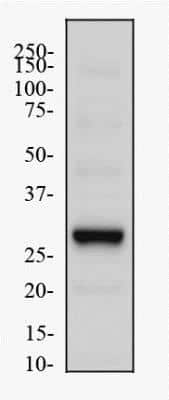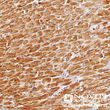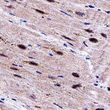PHD3 (EGLN3) Rabbit Polyclonal Antibody
Frequently bought together (3)
Transient overexpression lysate of egl nine homolog 3 (C. elegans) (EGLN3)
USD 396.00
Other products for "PHD3"
Specifications
| Product Data | |
| Applications | WB |
| Recommended Dilution | Immunohistochemistry, Chromatin Immunoprecipitation (ChIP), Immunoprecipitation: 1:10-1:500, Chromatin Immunoprecipitation, Immunohistochemistry-Paraffin, Immunocytochemistry/ Immunofluorescence, Simple Western: 1:1000, Western Blot: 1:500-1:2000, Immunoblotting |
| Reactivities | Human, Mouse, Primate |
| Host | Rabbit |
| Clonality | Polyclonal |
| Immunogen | A synthetic peptide made to the C-terminus of humanPHD3/HIF Prolyl Hydroxylase 3. [LocusLink ID 112399] |
| Formulation | Tris-citrate/phosphate, pH 7, 0.1% Sodium azide. Store at 4C. Do not freeze. |
| Concentration | lot specific |
| Purification | Immunogen affinity purified |
| Conjugation | Unconjugated |
| Storage | Store at -20°C as received. |
| Stability | Stable for 12 months from date of receipt. |
| Predicted Protein Size | 27 kDa |
| Gene Name | egl-9 family hypoxia inducible factor 3 |
| Database Link | |
| Background | HIF prolyl 4-hydroxylases (PHDs) are proyl hydroxylase domain-containing enzymes (PHD1/ Egln2, PHD2/ Egln1, PHD3/ Egln3, and P4H-TM) which are known for their role in mediating physiological responses to hypoxic stress via modulation of HIF1alpha expression levels. HIF-alpha subunit is regulated by hydroxylation, both by a family of PHDs leading to ubiquitination and proteasomal degradation, and by transcriptional inactivation following asparaginyl hydroxylation by FIH (factor inhibiting HIF). When oxygen levels are normal, HIF Prolyl Hydroxylase 3 (HIF-PH3/ PHD3/ Egln3) hydroxylates a specific proline found in HIF1A'a NODD/CODD domains and also hydroxylates HIF2A with preference for CODD site for HIF1A/HIF2A. Once hydroxylated, HIFs undergo proteasomal degradation via von Hippel-Lindau (VHL) ubiquitination complex. Upon hypoxic trigger, the hydroxylation reaction is tempered which let HIFs to escape degradation process leading to their nuclear translocation, heterodimerization with HIF1B, and increased expression of hypoxy-inducible genes. HIF-PH3 is the most important isozyme in limiting physiological activation of HIFs (particularly HIF2A) in hypoxia. Besides HIFs, in hypoxic conditions HIF-PH3 also hydroxylates PKM (thereby limiting glycolysis) and hydroxylates/regulates the stability of ADRB2. In cardiomyocytes, HIF-PH3 inhibits Bcl2's anti-apoptotic effect by disrupting the BAX-BCL2 complex, and in neurons, HIF-PH3 has a NGF-induced proapoptotic effect mediated via CASP3 activity regulation. HIF-PH3 also plays a crucial role in DNA damage response by hydroxylating TELO2, promoting its interaction with ATR which is required for activation of the ATR/CHK1/p53 pathway. |
| Synonyms | HIFP4H3; HIFPH3; PHD3 |
| Note | This PHD3/HIF Prolyl Hydroxylase 3 antibody is useful for Immunoprecipitation and Western blot, where a band is seen at ~27 kDa. This antibody has been tested against HeLa and MEF cell lysates. Immunoprecipitation was reported in PMID: 21575608. Chromatin Immunoprecipitation was reported in scientific literature. |
| Reference Data | |
| Protein Families | Druggable Genome |
| Protein Pathways | Pathways in cancer, Renal cell carcinoma |
Documents
| Product Manuals |
| FAQs |
| SDS |
{0} Product Review(s)
0 Product Review(s)
Submit review
Be the first one to submit a review
Product Citations
*Delivery time may vary from web posted schedule. Occasional delays may occur due to unforeseen
complexities in the preparation of your product. International customers may expect an additional 1-2 weeks
in shipping.






























































































































































































































































 Germany
Germany
 Japan
Japan
 United Kingdom
United Kingdom
 China
China







